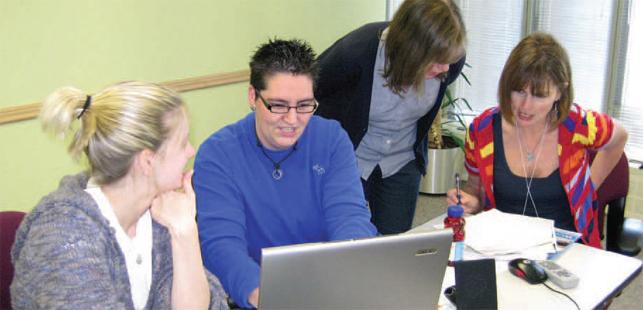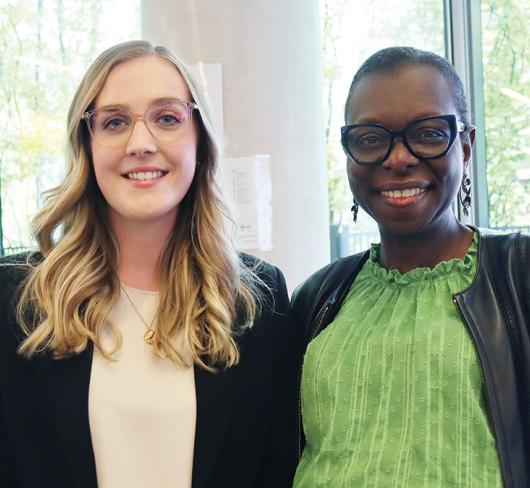
Special Education Teachers: Community of Learners (Professional Services)
Professional learning for teachers has come a long way from the days of “sit and get” workshops covering topics mandated from on high. Learning through collaboration with colleagues, deepening knowledge and skills in a focused area, and learning over time with the ability to apply new learning and reflect on the experiences are all hallmarks of meaningful professional learning for educators. The ETFO project Special Education Teachers: Community of Learners was able to provide special education teachers across Ontario with an exciting professional learning opportunity based on these principles of effective professional learning.
Providing high-quality professional learning to members is one of the cornerstones of our union. Funding provided by the Government of Ontario, through the Ministry of Education, has allowed for a rich, in-depth learning opportunity at little cost to the participants. Special Education Teachers:Community of Learners focused on:
- working collaboratively with classroom teachers to support students with special needs in their classes
- increasing knowledge of coaching skills
- increasing knowledge and understanding of differentiated instruction (DI) as a key way to program for students with special needs in the regular class.
During the course of the year-long project, 20 special education teachers from across the province came together to form a community of learners. They met as a group three times, for a total of six days of face-to-face sessions. In addition to these face-to-face sessions, the project also included an online component. The participants committed to completing a project that involved working with a partner classroom teacher and sharing a presentation about their project with the group.
The structure of the project contributed greatly to the success the participants experienced. Learning over time, with the opportunity to apply and reflect on their new knowledge and insights, was a meaningful, job-embedded growth experience that many participants had never experienced before. Meeting several times over the course of the year allowed for the application of and reflection on new learning as well as the opportunity to scaffold their learning. It also provided teachers with an opportunity to re-energize and refocus on the project over time.
Because there were only 20 teachers in the group, the participants were able to develop significant relationships, providing each other with support and encouragement over the course of the project. Assigning teachers to a “home team” (five teams of four teachers each) was also a successful strategy. Having the teachers complete a survey prior to meeting for the first time allowed for the structuring of carefully crafted home teams based on participants’ interests, motivation, and needs. Having them introduce themselves to each other electronically paved the way for effective team building during the first face-to-face session. Feedback indicated that the support of their home team members was critical for the success of the project and for keeping participants motivated and accountable.
Each participant worked with a partner classroom teacher(s) to determine the project focus. The project topics reflected individual needs and readiness level regarding differentiating instruction and coaching skills for both the class- room teacher(s) and the special education teacher. Project topics included:
- creating class profiles
- linking diagnostic assessments and unit planning
- improving reading comprehension
- improving social skills and behaviour
- using flexible groupings.
Creating class profiles
In one example, the project participant put together an assessment and learning/multiple intelligences package for teachers to use. She then modelled for the teachers how to gather and use this information when programming for students. She worked with several class- room teachers, using this information in various ways, based on their needs. She worked collaboratively with one teacher to create a spelling program based on DI activities that reflected the students’ learning profiles. She and two other classroom teachers worked together to create a differentiated character education unit; and together with a fourth classroom teacher she created and implemented a social skills program based on DI principles.
Improving reading comprehension
In this project some participants worked as part of the team with the Junior and Intermediate classroom teachers to improve knowledge and practice in three interconnected areas: comprehensive literacy instruction, comprehension strategies, and differentiated instruction. Over several months the teachers com- piled data and information to help them know their students. They used this data to collaboratively plan activities to meet the level and interests of their students, incorporated flexible groupings into their planned activities (e.g., based on reading level, interest, or learning style), used tiered graphic organizers for various comprehension strategies, and incorporated inclusive technology (e.g., Kurzweil or WordQ) as applicable.
Participants’ feedback
Members indicated they felt motivated, more knowledgeable about differentiating instruction, and more comfortable in working collaboratively with classroom teachers. All indicated growth, on a continuum ranging from an awareness to mastery level regarding DI and key coaching concepts. This project reinforced the fact that professional learning is meaningful and rich when it is voluntary and selected by teachers to meet their own identified needs. It underscores and reinforces the understanding that teachers learn best with and from each other in job- embedded opportunities. Recognizing and supporting the passion and enthusiasm educators have as they strive to do the best for the students in their care, and supporting them as they refine their teaching craft, continue to be top priorities for ETFO.
Participants’ feedback
“This project has impacted my work with teachers, as they have a better understanding of classroom profiles and how assessment can guide their planning, instruction, and assessments. Students’ level of achievement has increased from the strategies put in place in this project.”
“My teaching partner is very enthused about her program and the use of student profiles to inform her teaching. Students are more engaged in learning.”
“This project gave me the confidence to coach other teachers through the strategies that were given to me.”
“I am much more confident in working with teachers on programming in their classes.”
